Report on Organisational Behaviours: A Case Study of Tesco Plc
VerifiedAdded on 2023/06/11
|21
|5719
|218
Report
AI Summary
This report provides an in-depth analysis of organisational behaviour within Tesco Plc, focusing on the influence of culture, politics, and power dynamics, including French and Raven's power types. It explores the significance of motivation, detailing various motivational theories such as content and process theories. The report further examines team dynamics and relevant theories, alongside situational leadership theory for managing challenging situations. Key models such as Handy's culture model and Hofstede's six dimensions are applied to understand Tesco's organisational environment, highlighting the importance of cultural awareness and effective human resource management in achieving organisational goals.
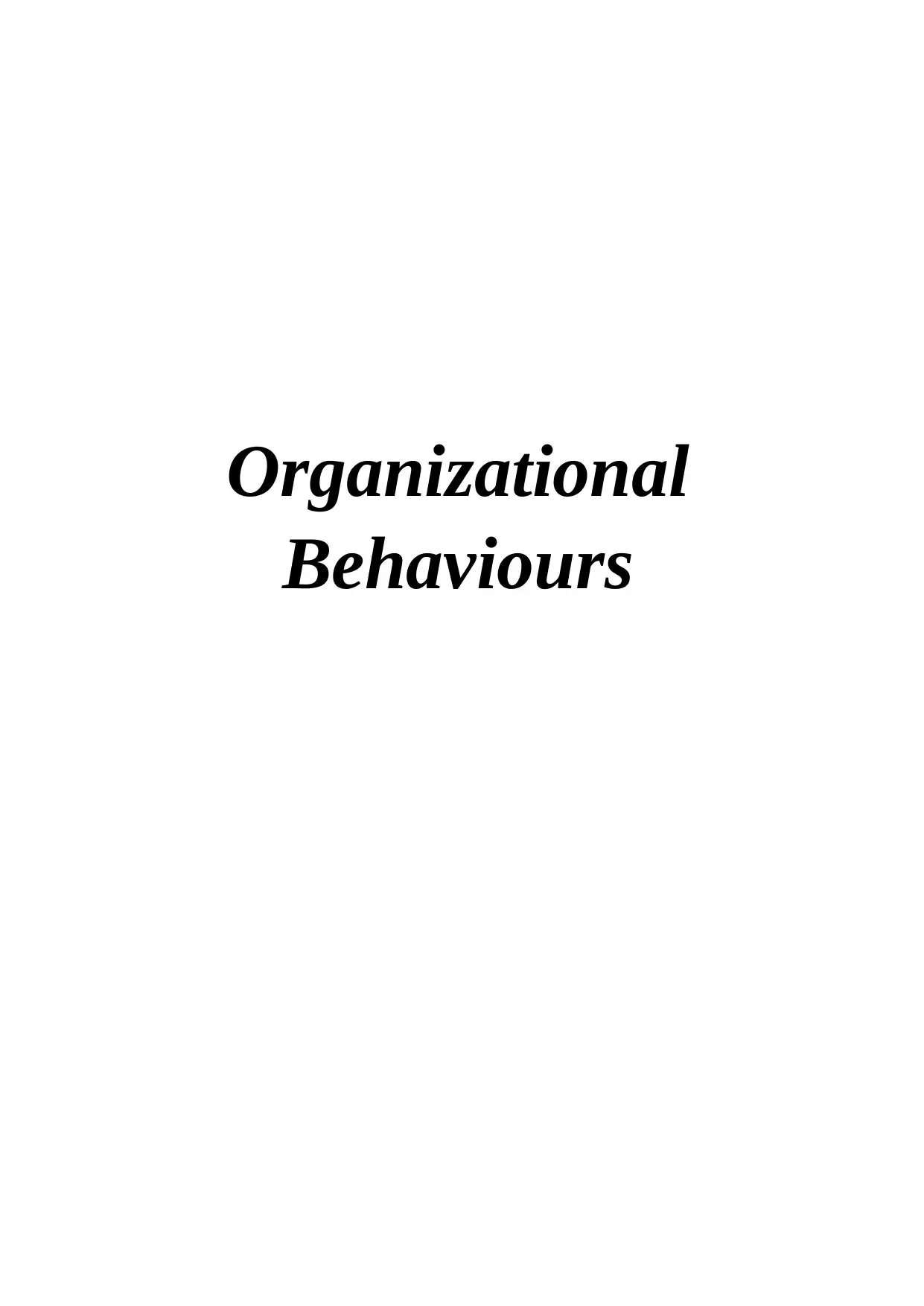
Organizational
Behaviours
Behaviours
Paraphrase This Document
Need a fresh take? Get an instant paraphrase of this document with our AI Paraphraser
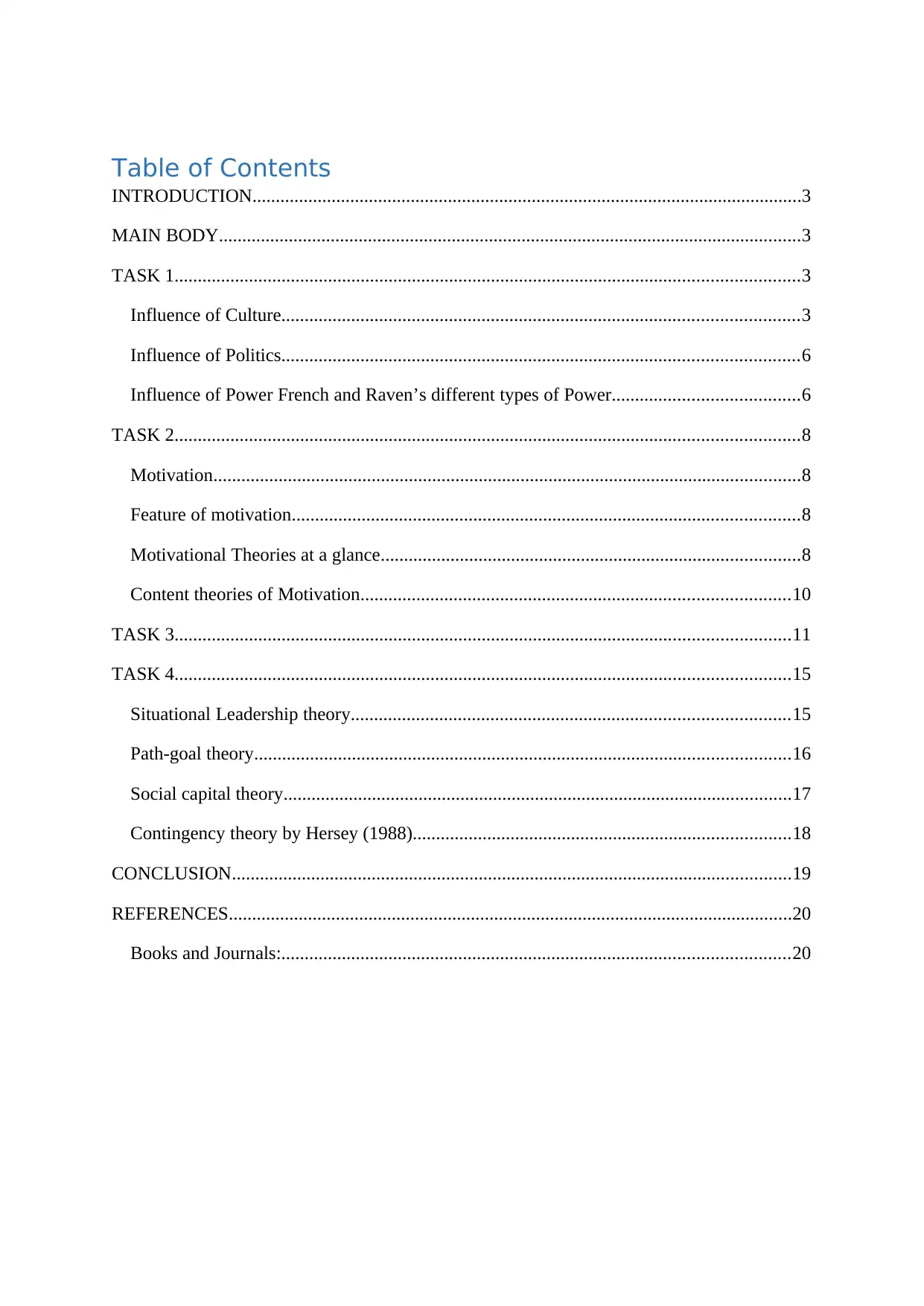
Table of Contents
INTRODUCTION......................................................................................................................3
MAIN BODY.............................................................................................................................3
TASK 1......................................................................................................................................3
Influence of Culture...............................................................................................................3
Influence of Politics...............................................................................................................6
Influence of Power French and Raven’s different types of Power........................................6
TASK 2......................................................................................................................................8
Motivation..............................................................................................................................8
Feature of motivation.............................................................................................................8
Motivational Theories at a glance..........................................................................................8
Content theories of Motivation............................................................................................10
TASK 3....................................................................................................................................11
TASK 4....................................................................................................................................15
Situational Leadership theory..............................................................................................15
Path-goal theory...................................................................................................................16
Social capital theory.............................................................................................................17
Contingency theory by Hersey (1988).................................................................................18
CONCLUSION........................................................................................................................19
REFERENCES.........................................................................................................................20
Books and Journals:.............................................................................................................20
INTRODUCTION......................................................................................................................3
MAIN BODY.............................................................................................................................3
TASK 1......................................................................................................................................3
Influence of Culture...............................................................................................................3
Influence of Politics...............................................................................................................6
Influence of Power French and Raven’s different types of Power........................................6
TASK 2......................................................................................................................................8
Motivation..............................................................................................................................8
Feature of motivation.............................................................................................................8
Motivational Theories at a glance..........................................................................................8
Content theories of Motivation............................................................................................10
TASK 3....................................................................................................................................11
TASK 4....................................................................................................................................15
Situational Leadership theory..............................................................................................15
Path-goal theory...................................................................................................................16
Social capital theory.............................................................................................................17
Contingency theory by Hersey (1988).................................................................................18
CONCLUSION........................................................................................................................19
REFERENCES.........................................................................................................................20
Books and Journals:.............................................................................................................20
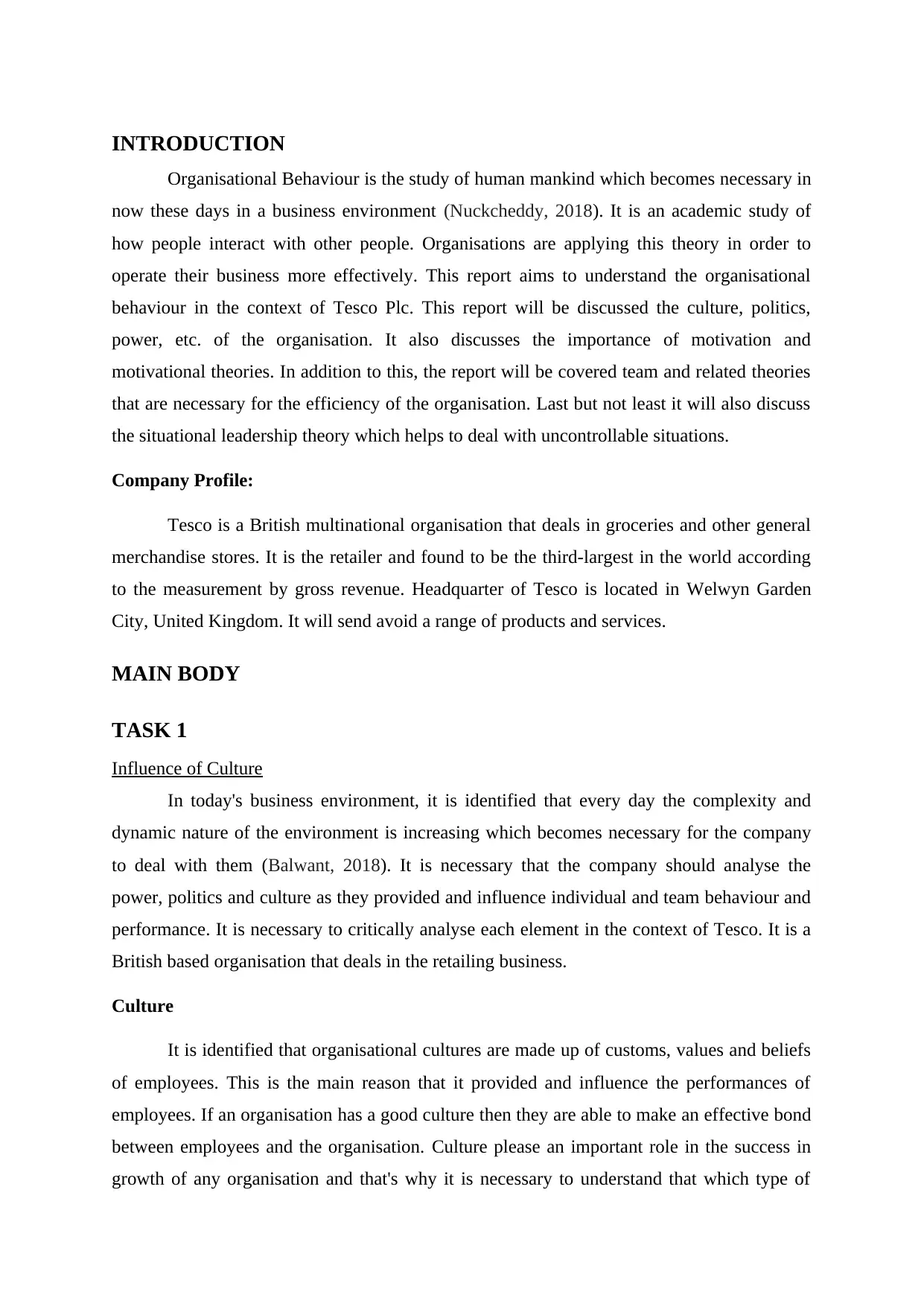
INTRODUCTION
Organisational Behaviour is the study of human mankind which becomes necessary in
now these days in a business environment (Nuckcheddy, 2018). It is an academic study of
how people interact with other people. Organisations are applying this theory in order to
operate their business more effectively. This report aims to understand the organisational
behaviour in the context of Tesco Plc. This report will be discussed the culture, politics,
power, etc. of the organisation. It also discusses the importance of motivation and
motivational theories. In addition to this, the report will be covered team and related theories
that are necessary for the efficiency of the organisation. Last but not least it will also discuss
the situational leadership theory which helps to deal with uncontrollable situations.
Company Profile:
Tesco is a British multinational organisation that deals in groceries and other general
merchandise stores. It is the retailer and found to be the third-largest in the world according
to the measurement by gross revenue. Headquarter of Tesco is located in Welwyn Garden
City, United Kingdom. It will send avoid a range of products and services.
MAIN BODY
TASK 1
Influence of Culture
In today's business environment, it is identified that every day the complexity and
dynamic nature of the environment is increasing which becomes necessary for the company
to deal with them (Balwant, 2018). It is necessary that the company should analyse the
power, politics and culture as they provided and influence individual and team behaviour and
performance. It is necessary to critically analyse each element in the context of Tesco. It is a
British based organisation that deals in the retailing business.
Culture
It is identified that organisational cultures are made up of customs, values and beliefs
of employees. This is the main reason that it provided and influence the performances of
employees. If an organisation has a good culture then they are able to make an effective bond
between employees and the organisation. Culture please an important role in the success in
growth of any organisation and that's why it is necessary to understand that which type of
Organisational Behaviour is the study of human mankind which becomes necessary in
now these days in a business environment (Nuckcheddy, 2018). It is an academic study of
how people interact with other people. Organisations are applying this theory in order to
operate their business more effectively. This report aims to understand the organisational
behaviour in the context of Tesco Plc. This report will be discussed the culture, politics,
power, etc. of the organisation. It also discusses the importance of motivation and
motivational theories. In addition to this, the report will be covered team and related theories
that are necessary for the efficiency of the organisation. Last but not least it will also discuss
the situational leadership theory which helps to deal with uncontrollable situations.
Company Profile:
Tesco is a British multinational organisation that deals in groceries and other general
merchandise stores. It is the retailer and found to be the third-largest in the world according
to the measurement by gross revenue. Headquarter of Tesco is located in Welwyn Garden
City, United Kingdom. It will send avoid a range of products and services.
MAIN BODY
TASK 1
Influence of Culture
In today's business environment, it is identified that every day the complexity and
dynamic nature of the environment is increasing which becomes necessary for the company
to deal with them (Balwant, 2018). It is necessary that the company should analyse the
power, politics and culture as they provided and influence individual and team behaviour and
performance. It is necessary to critically analyse each element in the context of Tesco. It is a
British based organisation that deals in the retailing business.
Culture
It is identified that organisational cultures are made up of customs, values and beliefs
of employees. This is the main reason that it provided and influence the performances of
employees. If an organisation has a good culture then they are able to make an effective bond
between employees and the organisation. Culture please an important role in the success in
growth of any organisation and that's why it is necessary to understand that which type of
⊘ This is a preview!⊘
Do you want full access?
Subscribe today to unlock all pages.

Trusted by 1+ million students worldwide
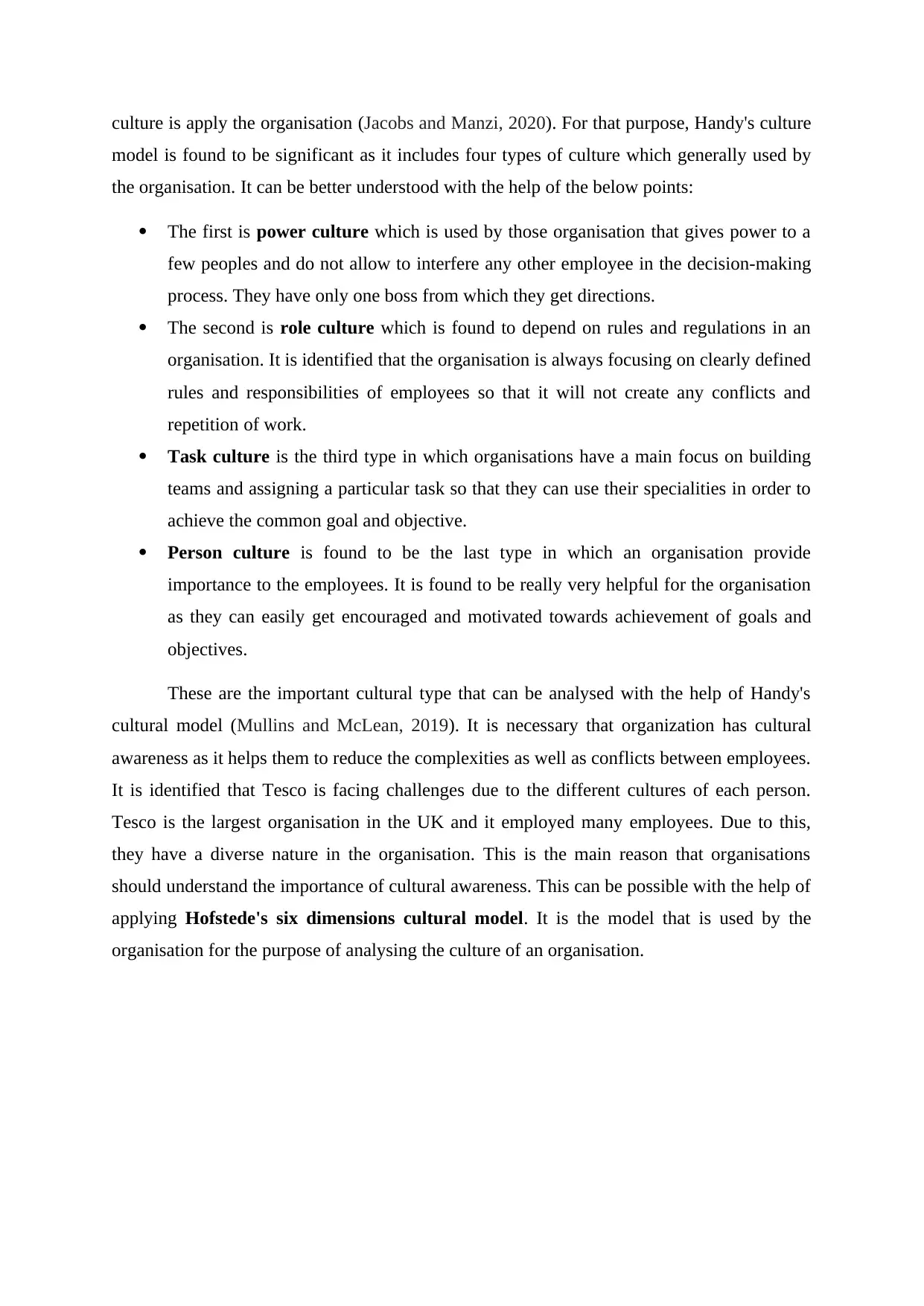
culture is apply the organisation (Jacobs and Manzi, 2020). For that purpose, Handy's culture
model is found to be significant as it includes four types of culture which generally used by
the organisation. It can be better understood with the help of the below points:
The first is power culture which is used by those organisation that gives power to a
few peoples and do not allow to interfere any other employee in the decision-making
process. They have only one boss from which they get directions.
The second is role culture which is found to depend on rules and regulations in an
organisation. It is identified that the organisation is always focusing on clearly defined
rules and responsibilities of employees so that it will not create any conflicts and
repetition of work.
Task culture is the third type in which organisations have a main focus on building
teams and assigning a particular task so that they can use their specialities in order to
achieve the common goal and objective.
Person culture is found to be the last type in which an organisation provide
importance to the employees. It is found to be really very helpful for the organisation
as they can easily get encouraged and motivated towards achievement of goals and
objectives.
These are the important cultural type that can be analysed with the help of Handy's
cultural model (Mullins and McLean, 2019). It is necessary that organization has cultural
awareness as it helps them to reduce the complexities as well as conflicts between employees.
It is identified that Tesco is facing challenges due to the different cultures of each person.
Tesco is the largest organisation in the UK and it employed many employees. Due to this,
they have a diverse nature in the organisation. This is the main reason that organisations
should understand the importance of cultural awareness. This can be possible with the help of
applying Hofstede's six dimensions cultural model. It is the model that is used by the
organisation for the purpose of analysing the culture of an organisation.
model is found to be significant as it includes four types of culture which generally used by
the organisation. It can be better understood with the help of the below points:
The first is power culture which is used by those organisation that gives power to a
few peoples and do not allow to interfere any other employee in the decision-making
process. They have only one boss from which they get directions.
The second is role culture which is found to depend on rules and regulations in an
organisation. It is identified that the organisation is always focusing on clearly defined
rules and responsibilities of employees so that it will not create any conflicts and
repetition of work.
Task culture is the third type in which organisations have a main focus on building
teams and assigning a particular task so that they can use their specialities in order to
achieve the common goal and objective.
Person culture is found to be the last type in which an organisation provide
importance to the employees. It is found to be really very helpful for the organisation
as they can easily get encouraged and motivated towards achievement of goals and
objectives.
These are the important cultural type that can be analysed with the help of Handy's
cultural model (Mullins and McLean, 2019). It is necessary that organization has cultural
awareness as it helps them to reduce the complexities as well as conflicts between employees.
It is identified that Tesco is facing challenges due to the different cultures of each person.
Tesco is the largest organisation in the UK and it employed many employees. Due to this,
they have a diverse nature in the organisation. This is the main reason that organisations
should understand the importance of cultural awareness. This can be possible with the help of
applying Hofstede's six dimensions cultural model. It is the model that is used by the
organisation for the purpose of analysing the culture of an organisation.
Paraphrase This Document
Need a fresh take? Get an instant paraphrase of this document with our AI Paraphraser
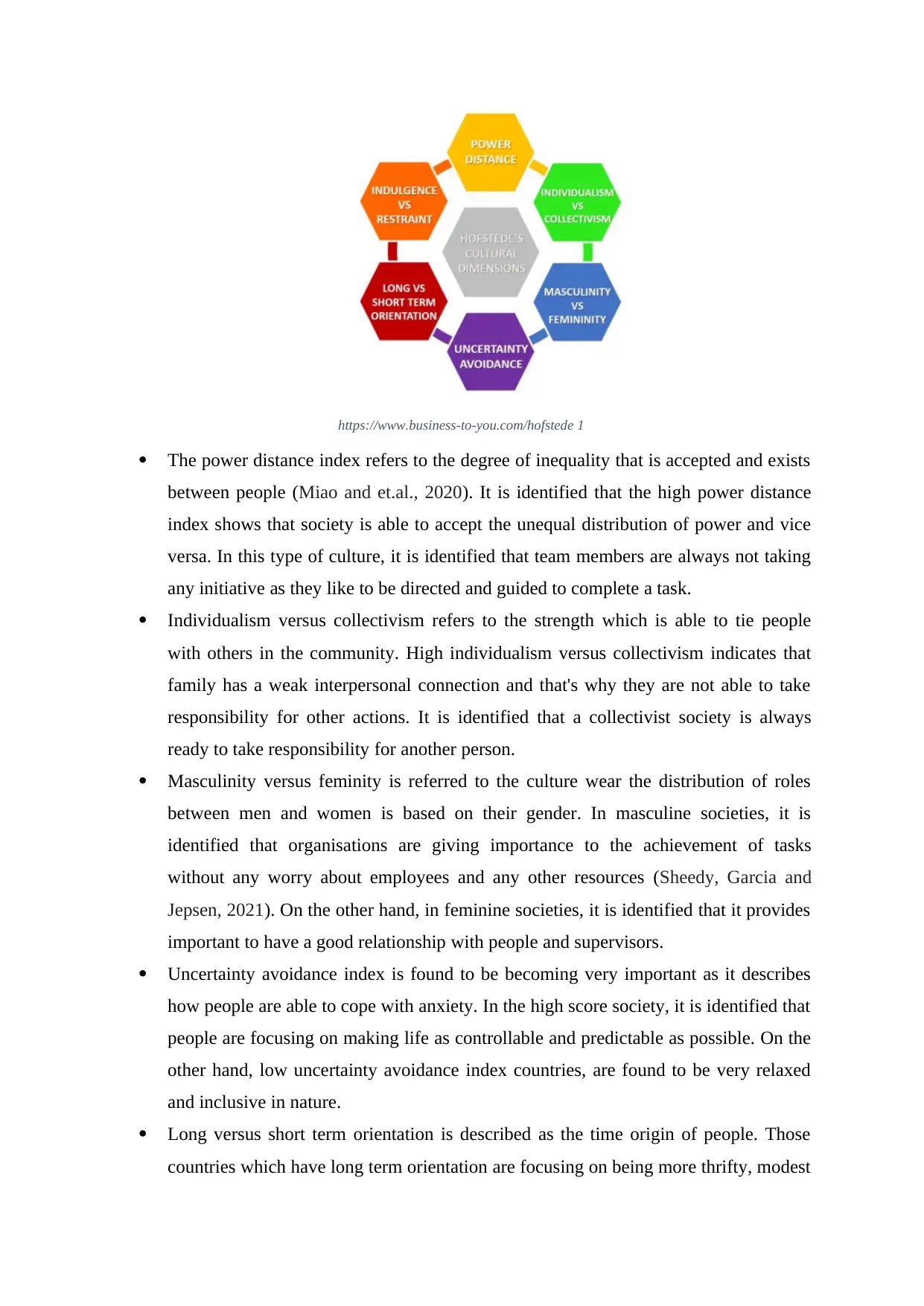
https://www.business-to-you.com/hofstede 1
The power distance index refers to the degree of inequality that is accepted and exists
between people (Miao and et.al., 2020). It is identified that the high power distance
index shows that society is able to accept the unequal distribution of power and vice
versa. In this type of culture, it is identified that team members are always not taking
any initiative as they like to be directed and guided to complete a task.
Individualism versus collectivism refers to the strength which is able to tie people
with others in the community. High individualism versus collectivism indicates that
family has a weak interpersonal connection and that's why they are not able to take
responsibility for other actions. It is identified that a collectivist society is always
ready to take responsibility for another person.
Masculinity versus feminity is referred to the culture wear the distribution of roles
between men and women is based on their gender. In masculine societies, it is
identified that organisations are giving importance to the achievement of tasks
without any worry about employees and any other resources (Sheedy, Garcia and
Jepsen, 2021). On the other hand, in feminine societies, it is identified that it provides
important to have a good relationship with people and supervisors.
Uncertainty avoidance index is found to be becoming very important as it describes
how people are able to cope with anxiety. In the high score society, it is identified that
people are focusing on making life as controllable and predictable as possible. On the
other hand, low uncertainty avoidance index countries, are found to be very relaxed
and inclusive in nature.
Long versus short term orientation is described as the time origin of people. Those
countries which have long term orientation are focusing on being more thrifty, modest
The power distance index refers to the degree of inequality that is accepted and exists
between people (Miao and et.al., 2020). It is identified that the high power distance
index shows that society is able to accept the unequal distribution of power and vice
versa. In this type of culture, it is identified that team members are always not taking
any initiative as they like to be directed and guided to complete a task.
Individualism versus collectivism refers to the strength which is able to tie people
with others in the community. High individualism versus collectivism indicates that
family has a weak interpersonal connection and that's why they are not able to take
responsibility for other actions. It is identified that a collectivist society is always
ready to take responsibility for another person.
Masculinity versus feminity is referred to the culture wear the distribution of roles
between men and women is based on their gender. In masculine societies, it is
identified that organisations are giving importance to the achievement of tasks
without any worry about employees and any other resources (Sheedy, Garcia and
Jepsen, 2021). On the other hand, in feminine societies, it is identified that it provides
important to have a good relationship with people and supervisors.
Uncertainty avoidance index is found to be becoming very important as it describes
how people are able to cope with anxiety. In the high score society, it is identified that
people are focusing on making life as controllable and predictable as possible. On the
other hand, low uncertainty avoidance index countries, are found to be very relaxed
and inclusive in nature.
Long versus short term orientation is described as the time origin of people. Those
countries which have long term orientation are focusing on being more thrifty, modest
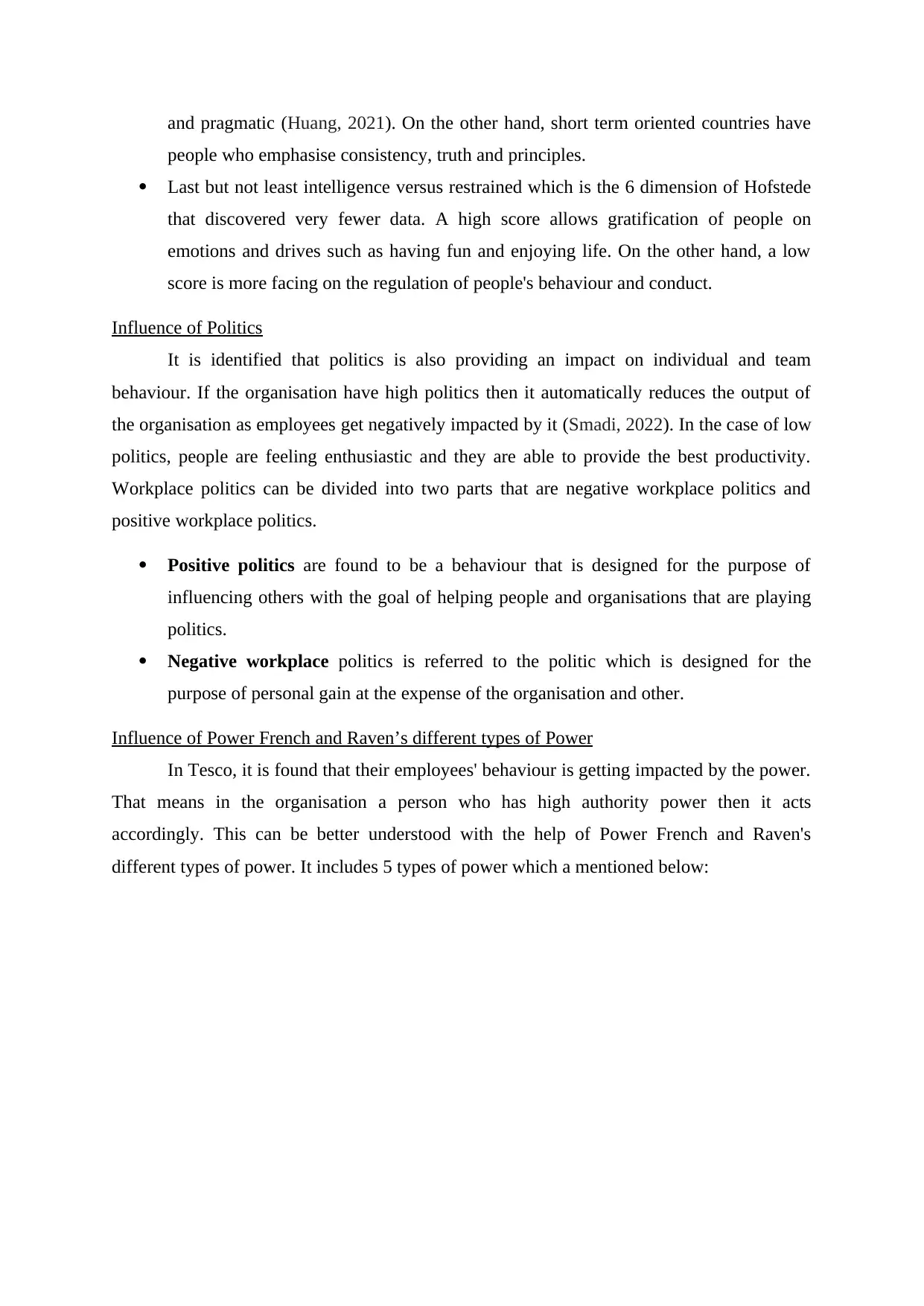
and pragmatic (Huang, 2021). On the other hand, short term oriented countries have
people who emphasise consistency, truth and principles.
Last but not least intelligence versus restrained which is the 6 dimension of Hofstede
that discovered very fewer data. A high score allows gratification of people on
emotions and drives such as having fun and enjoying life. On the other hand, a low
score is more facing on the regulation of people's behaviour and conduct.
Influence of Politics
It is identified that politics is also providing an impact on individual and team
behaviour. If the organisation have high politics then it automatically reduces the output of
the organisation as employees get negatively impacted by it (Smadi, 2022). In the case of low
politics, people are feeling enthusiastic and they are able to provide the best productivity.
Workplace politics can be divided into two parts that are negative workplace politics and
positive workplace politics.
Positive politics are found to be a behaviour that is designed for the purpose of
influencing others with the goal of helping people and organisations that are playing
politics.
Negative workplace politics is referred to the politic which is designed for the
purpose of personal gain at the expense of the organisation and other.
Influence of Power French and Raven’s different types of Power
In Tesco, it is found that their employees' behaviour is getting impacted by the power.
That means in the organisation a person who has high authority power then it acts
accordingly. This can be better understood with the help of Power French and Raven's
different types of power. It includes 5 types of power which a mentioned below:
people who emphasise consistency, truth and principles.
Last but not least intelligence versus restrained which is the 6 dimension of Hofstede
that discovered very fewer data. A high score allows gratification of people on
emotions and drives such as having fun and enjoying life. On the other hand, a low
score is more facing on the regulation of people's behaviour and conduct.
Influence of Politics
It is identified that politics is also providing an impact on individual and team
behaviour. If the organisation have high politics then it automatically reduces the output of
the organisation as employees get negatively impacted by it (Smadi, 2022). In the case of low
politics, people are feeling enthusiastic and they are able to provide the best productivity.
Workplace politics can be divided into two parts that are negative workplace politics and
positive workplace politics.
Positive politics are found to be a behaviour that is designed for the purpose of
influencing others with the goal of helping people and organisations that are playing
politics.
Negative workplace politics is referred to the politic which is designed for the
purpose of personal gain at the expense of the organisation and other.
Influence of Power French and Raven’s different types of Power
In Tesco, it is found that their employees' behaviour is getting impacted by the power.
That means in the organisation a person who has high authority power then it acts
accordingly. This can be better understood with the help of Power French and Raven's
different types of power. It includes 5 types of power which a mentioned below:
⊘ This is a preview!⊘
Do you want full access?
Subscribe today to unlock all pages.

Trusted by 1+ million students worldwide
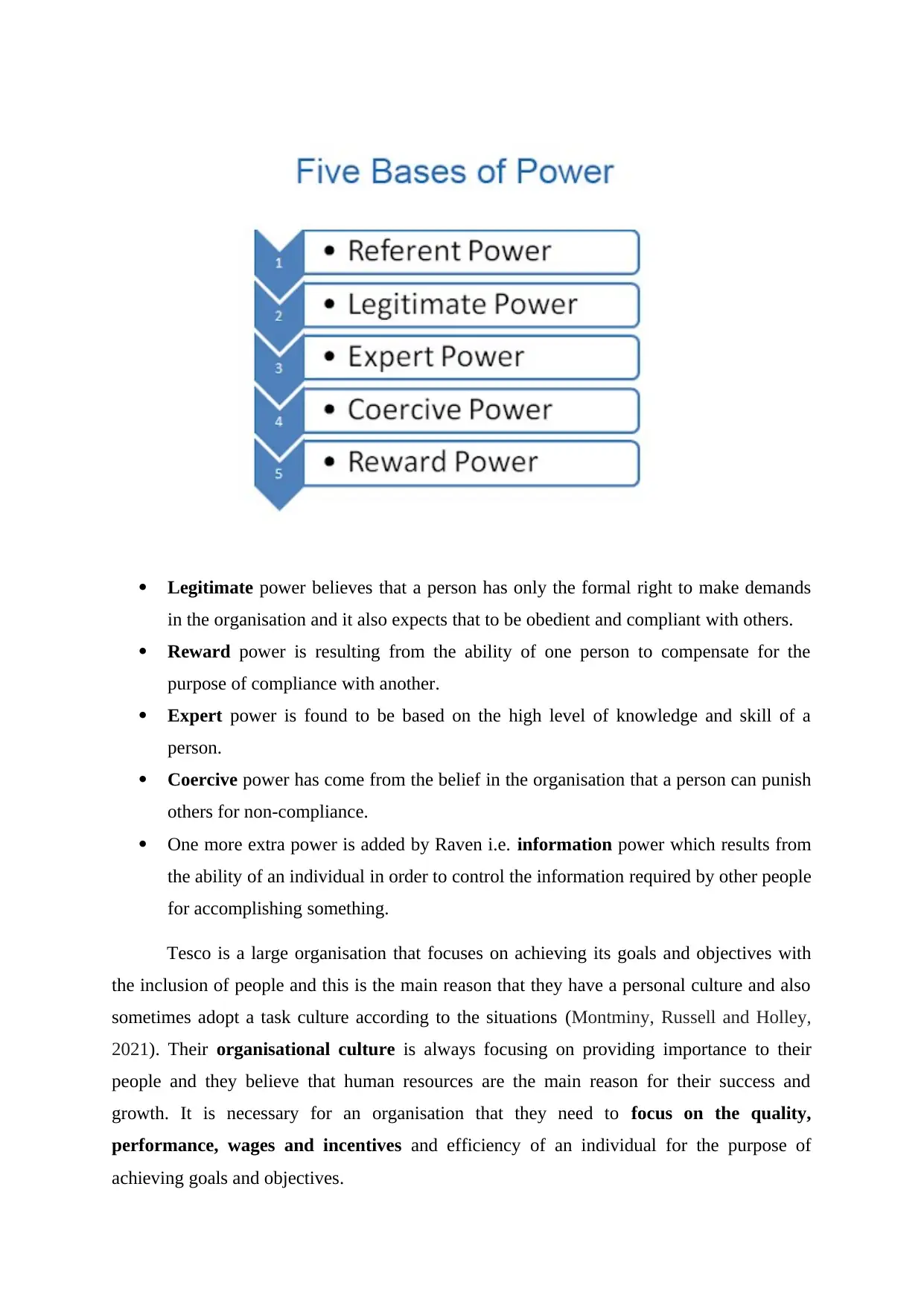
Legitimate power believes that a person has only the formal right to make demands
in the organisation and it also expects that to be obedient and compliant with others.
Reward power is resulting from the ability of one person to compensate for the
purpose of compliance with another.
Expert power is found to be based on the high level of knowledge and skill of a
person.
Coercive power has come from the belief in the organisation that a person can punish
others for non-compliance.
One more extra power is added by Raven i.e. information power which results from
the ability of an individual in order to control the information required by other people
for accomplishing something.
Tesco is a large organisation that focuses on achieving its goals and objectives with
the inclusion of people and this is the main reason that they have a personal culture and also
sometimes adopt a task culture according to the situations (Montminy, Russell and Holley,
2021). Their organisational culture is always focusing on providing importance to their
people and they believe that human resources are the main reason for their success and
growth. It is necessary for an organisation that they need to focus on the quality,
performance, wages and incentives and efficiency of an individual for the purpose of
achieving goals and objectives.
in the organisation and it also expects that to be obedient and compliant with others.
Reward power is resulting from the ability of one person to compensate for the
purpose of compliance with another.
Expert power is found to be based on the high level of knowledge and skill of a
person.
Coercive power has come from the belief in the organisation that a person can punish
others for non-compliance.
One more extra power is added by Raven i.e. information power which results from
the ability of an individual in order to control the information required by other people
for accomplishing something.
Tesco is a large organisation that focuses on achieving its goals and objectives with
the inclusion of people and this is the main reason that they have a personal culture and also
sometimes adopt a task culture according to the situations (Montminy, Russell and Holley,
2021). Their organisational culture is always focusing on providing importance to their
people and they believe that human resources are the main reason for their success and
growth. It is necessary for an organisation that they need to focus on the quality,
performance, wages and incentives and efficiency of an individual for the purpose of
achieving goals and objectives.
Paraphrase This Document
Need a fresh take? Get an instant paraphrase of this document with our AI Paraphraser
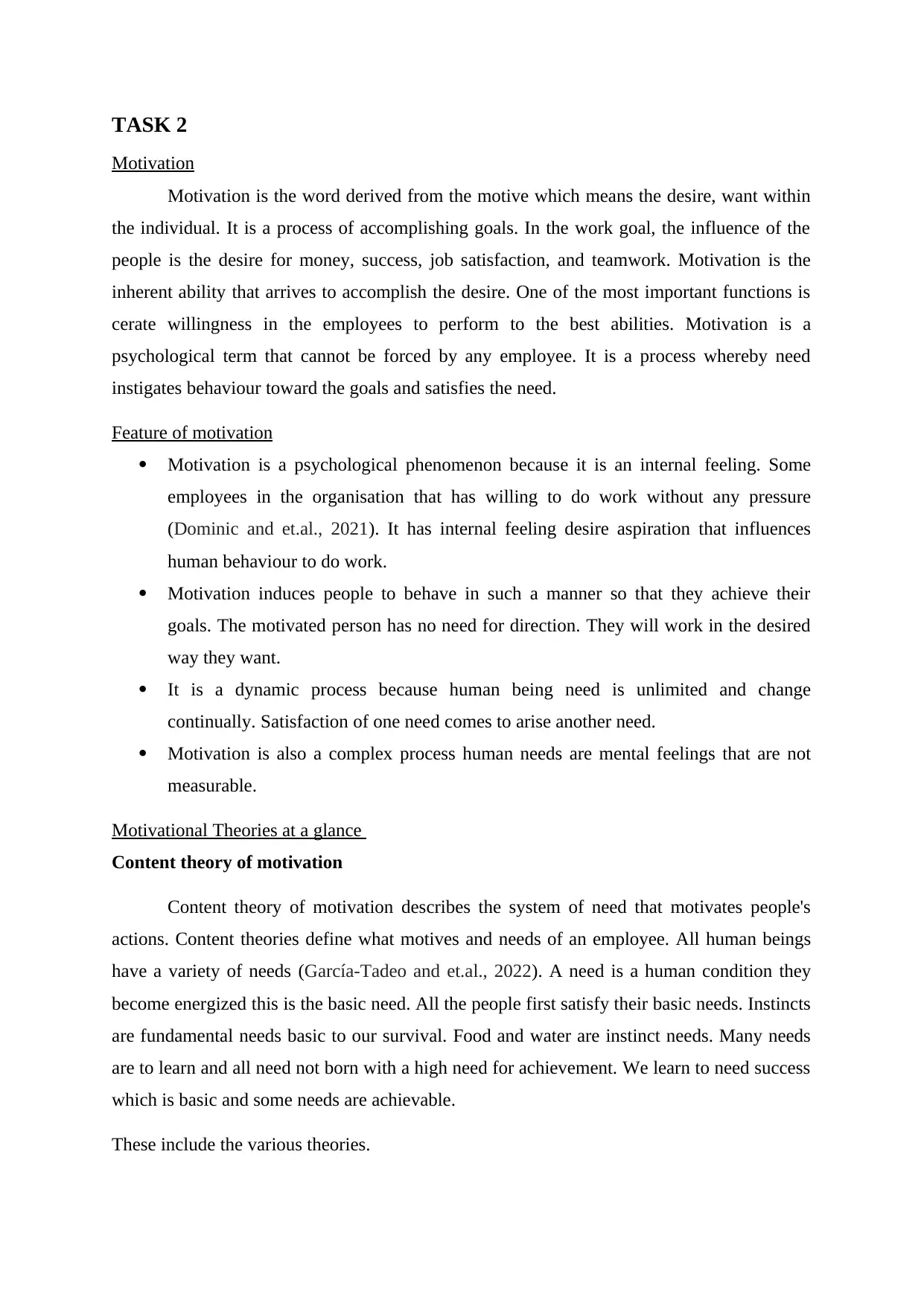
TASK 2
Motivation
Motivation is the word derived from the motive which means the desire, want within
the individual. It is a process of accomplishing goals. In the work goal, the influence of the
people is the desire for money, success, job satisfaction, and teamwork. Motivation is the
inherent ability that arrives to accomplish the desire. One of the most important functions is
cerate willingness in the employees to perform to the best abilities. Motivation is a
psychological term that cannot be forced by any employee. It is a process whereby need
instigates behaviour toward the goals and satisfies the need.
Feature of motivation
Motivation is a psychological phenomenon because it is an internal feeling. Some
employees in the organisation that has willing to do work without any pressure
(Dominic and et.al., 2021). It has internal feeling desire aspiration that influences
human behaviour to do work.
Motivation induces people to behave in such a manner so that they achieve their
goals. The motivated person has no need for direction. They will work in the desired
way they want.
It is a dynamic process because human being need is unlimited and change
continually. Satisfaction of one need comes to arise another need.
Motivation is also a complex process human needs are mental feelings that are not
measurable.
Motivational Theories at a glance
Content theory of motivation
Content theory of motivation describes the system of need that motivates people's
actions. Content theories define what motives and needs of an employee. All human beings
have a variety of needs (García-Tadeo and et.al., 2022). A need is a human condition they
become energized this is the basic need. All the people first satisfy their basic needs. Instincts
are fundamental needs basic to our survival. Food and water are instinct needs. Many needs
are to learn and all need not born with a high need for achievement. We learn to need success
which is basic and some needs are achievable.
These include the various theories.
Motivation
Motivation is the word derived from the motive which means the desire, want within
the individual. It is a process of accomplishing goals. In the work goal, the influence of the
people is the desire for money, success, job satisfaction, and teamwork. Motivation is the
inherent ability that arrives to accomplish the desire. One of the most important functions is
cerate willingness in the employees to perform to the best abilities. Motivation is a
psychological term that cannot be forced by any employee. It is a process whereby need
instigates behaviour toward the goals and satisfies the need.
Feature of motivation
Motivation is a psychological phenomenon because it is an internal feeling. Some
employees in the organisation that has willing to do work without any pressure
(Dominic and et.al., 2021). It has internal feeling desire aspiration that influences
human behaviour to do work.
Motivation induces people to behave in such a manner so that they achieve their
goals. The motivated person has no need for direction. They will work in the desired
way they want.
It is a dynamic process because human being need is unlimited and change
continually. Satisfaction of one need comes to arise another need.
Motivation is also a complex process human needs are mental feelings that are not
measurable.
Motivational Theories at a glance
Content theory of motivation
Content theory of motivation describes the system of need that motivates people's
actions. Content theories define what motives and needs of an employee. All human beings
have a variety of needs (García-Tadeo and et.al., 2022). A need is a human condition they
become energized this is the basic need. All the people first satisfy their basic needs. Instincts
are fundamental needs basic to our survival. Food and water are instinct needs. Many needs
are to learn and all need not born with a high need for achievement. We learn to need success
which is basic and some needs are achievable.
These include the various theories.
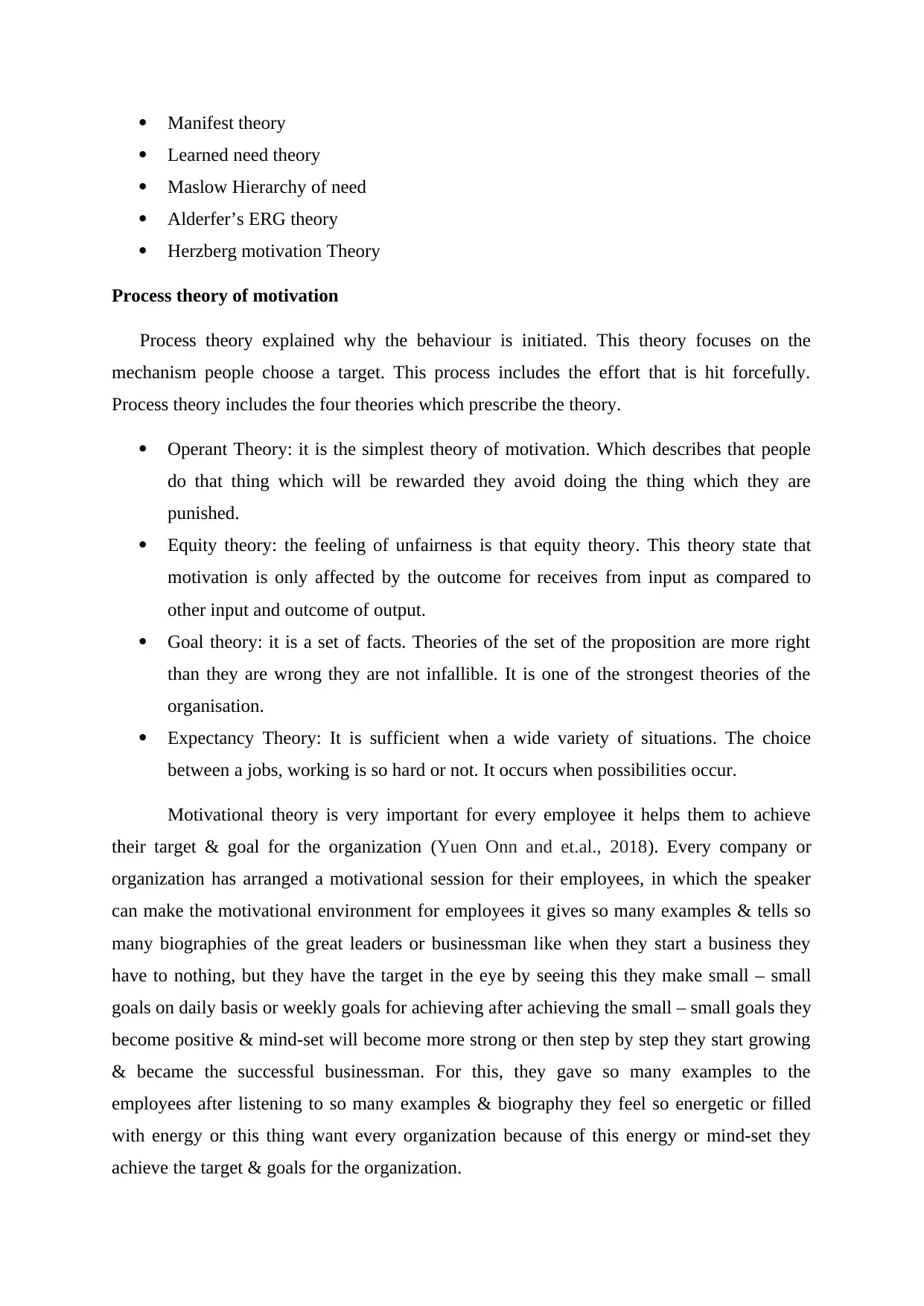
Manifest theory
Learned need theory
Maslow Hierarchy of need
Alderfer’s ERG theory
Herzberg motivation Theory
Process theory of motivation
Process theory explained why the behaviour is initiated. This theory focuses on the
mechanism people choose a target. This process includes the effort that is hit forcefully.
Process theory includes the four theories which prescribe the theory.
Operant Theory: it is the simplest theory of motivation. Which describes that people
do that thing which will be rewarded they avoid doing the thing which they are
punished.
Equity theory: the feeling of unfairness is that equity theory. This theory state that
motivation is only affected by the outcome for receives from input as compared to
other input and outcome of output.
Goal theory: it is a set of facts. Theories of the set of the proposition are more right
than they are wrong they are not infallible. It is one of the strongest theories of the
organisation.
Expectancy Theory: It is sufficient when a wide variety of situations. The choice
between a jobs, working is so hard or not. It occurs when possibilities occur.
Motivational theory is very important for every employee it helps them to achieve
their target & goal for the organization (Yuen Onn and et.al., 2018). Every company or
organization has arranged a motivational session for their employees, in which the speaker
can make the motivational environment for employees it gives so many examples & tells so
many biographies of the great leaders or businessman like when they start a business they
have to nothing, but they have the target in the eye by seeing this they make small – small
goals on daily basis or weekly goals for achieving after achieving the small – small goals they
become positive & mind-set will become more strong or then step by step they start growing
& became the successful businessman. For this, they gave so many examples to the
employees after listening to so many examples & biography they feel so energetic or filled
with energy or this thing want every organization because of this energy or mind-set they
achieve the target & goals for the organization.
Learned need theory
Maslow Hierarchy of need
Alderfer’s ERG theory
Herzberg motivation Theory
Process theory of motivation
Process theory explained why the behaviour is initiated. This theory focuses on the
mechanism people choose a target. This process includes the effort that is hit forcefully.
Process theory includes the four theories which prescribe the theory.
Operant Theory: it is the simplest theory of motivation. Which describes that people
do that thing which will be rewarded they avoid doing the thing which they are
punished.
Equity theory: the feeling of unfairness is that equity theory. This theory state that
motivation is only affected by the outcome for receives from input as compared to
other input and outcome of output.
Goal theory: it is a set of facts. Theories of the set of the proposition are more right
than they are wrong they are not infallible. It is one of the strongest theories of the
organisation.
Expectancy Theory: It is sufficient when a wide variety of situations. The choice
between a jobs, working is so hard or not. It occurs when possibilities occur.
Motivational theory is very important for every employee it helps them to achieve
their target & goal for the organization (Yuen Onn and et.al., 2018). Every company or
organization has arranged a motivational session for their employees, in which the speaker
can make the motivational environment for employees it gives so many examples & tells so
many biographies of the great leaders or businessman like when they start a business they
have to nothing, but they have the target in the eye by seeing this they make small – small
goals on daily basis or weekly goals for achieving after achieving the small – small goals they
become positive & mind-set will become more strong or then step by step they start growing
& became the successful businessman. For this, they gave so many examples to the
employees after listening to so many examples & biography they feel so energetic or filled
with energy or this thing want every organization because of this energy or mind-set they
achieve the target & goals for the organization.
⊘ This is a preview!⊘
Do you want full access?
Subscribe today to unlock all pages.

Trusted by 1+ million students worldwide
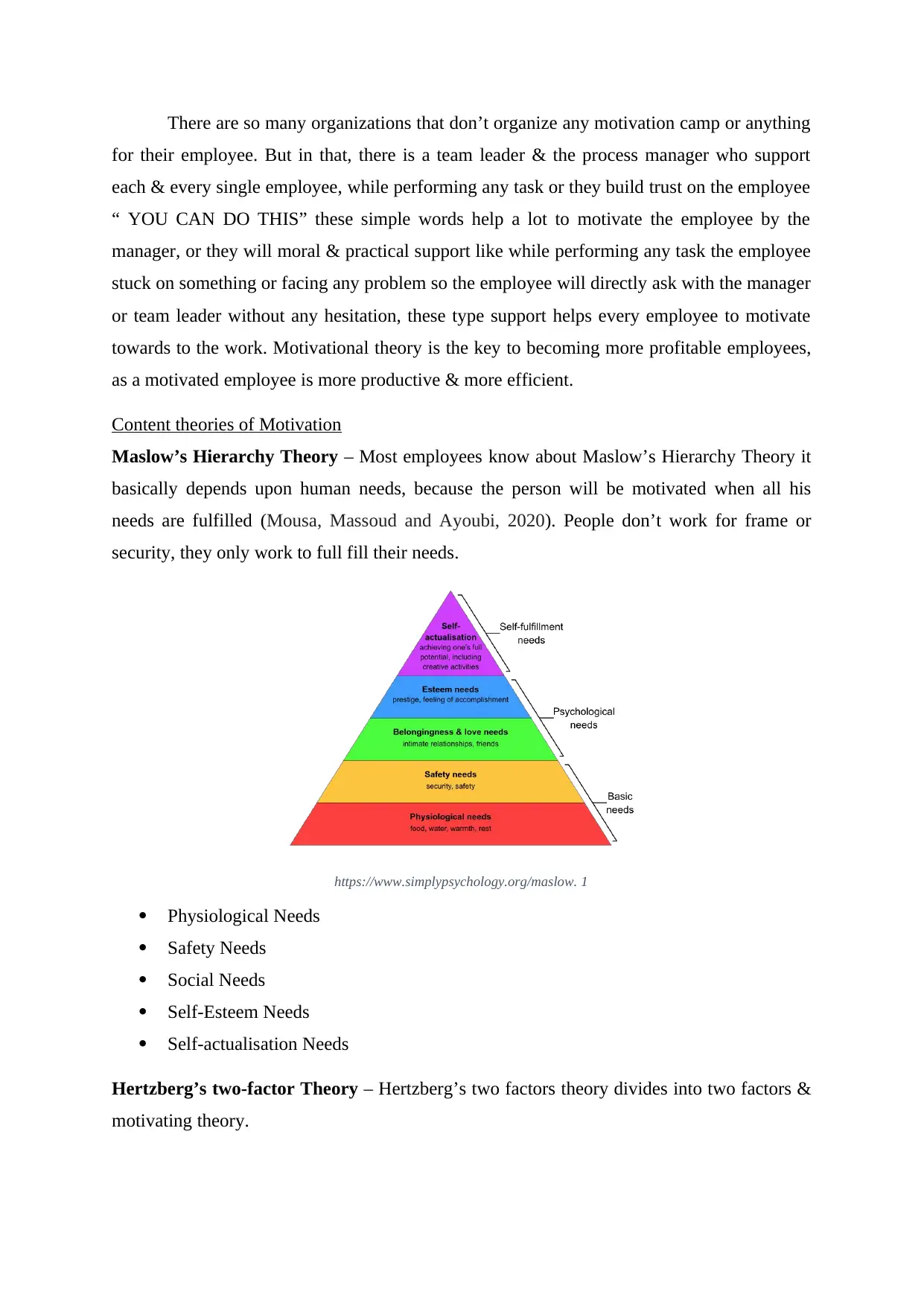
There are so many organizations that don’t organize any motivation camp or anything
for their employee. But in that, there is a team leader & the process manager who support
each & every single employee, while performing any task or they build trust on the employee
“ YOU CAN DO THIS” these simple words help a lot to motivate the employee by the
manager, or they will moral & practical support like while performing any task the employee
stuck on something or facing any problem so the employee will directly ask with the manager
or team leader without any hesitation, these type support helps every employee to motivate
towards to the work. Motivational theory is the key to becoming more profitable employees,
as a motivated employee is more productive & more efficient.
Content theories of Motivation
Maslow’s Hierarchy Theory – Most employees know about Maslow’s Hierarchy Theory it
basically depends upon human needs, because the person will be motivated when all his
needs are fulfilled (Mousa, Massoud and Ayoubi, 2020). People don’t work for frame or
security, they only work to full fill their needs.
https://www.simplypsychology.org/maslow. 1
Physiological Needs
Safety Needs
Social Needs
Self-Esteem Needs
Self-actualisation Needs
Hertzberg’s two-factor Theory – Hertzberg’s two factors theory divides into two factors &
motivating theory.
for their employee. But in that, there is a team leader & the process manager who support
each & every single employee, while performing any task or they build trust on the employee
“ YOU CAN DO THIS” these simple words help a lot to motivate the employee by the
manager, or they will moral & practical support like while performing any task the employee
stuck on something or facing any problem so the employee will directly ask with the manager
or team leader without any hesitation, these type support helps every employee to motivate
towards to the work. Motivational theory is the key to becoming more profitable employees,
as a motivated employee is more productive & more efficient.
Content theories of Motivation
Maslow’s Hierarchy Theory – Most employees know about Maslow’s Hierarchy Theory it
basically depends upon human needs, because the person will be motivated when all his
needs are fulfilled (Mousa, Massoud and Ayoubi, 2020). People don’t work for frame or
security, they only work to full fill their needs.
https://www.simplypsychology.org/maslow. 1
Physiological Needs
Safety Needs
Social Needs
Self-Esteem Needs
Self-actualisation Needs
Hertzberg’s two-factor Theory – Hertzberg’s two factors theory divides into two factors &
motivating theory.
Paraphrase This Document
Need a fresh take? Get an instant paraphrase of this document with our AI Paraphraser
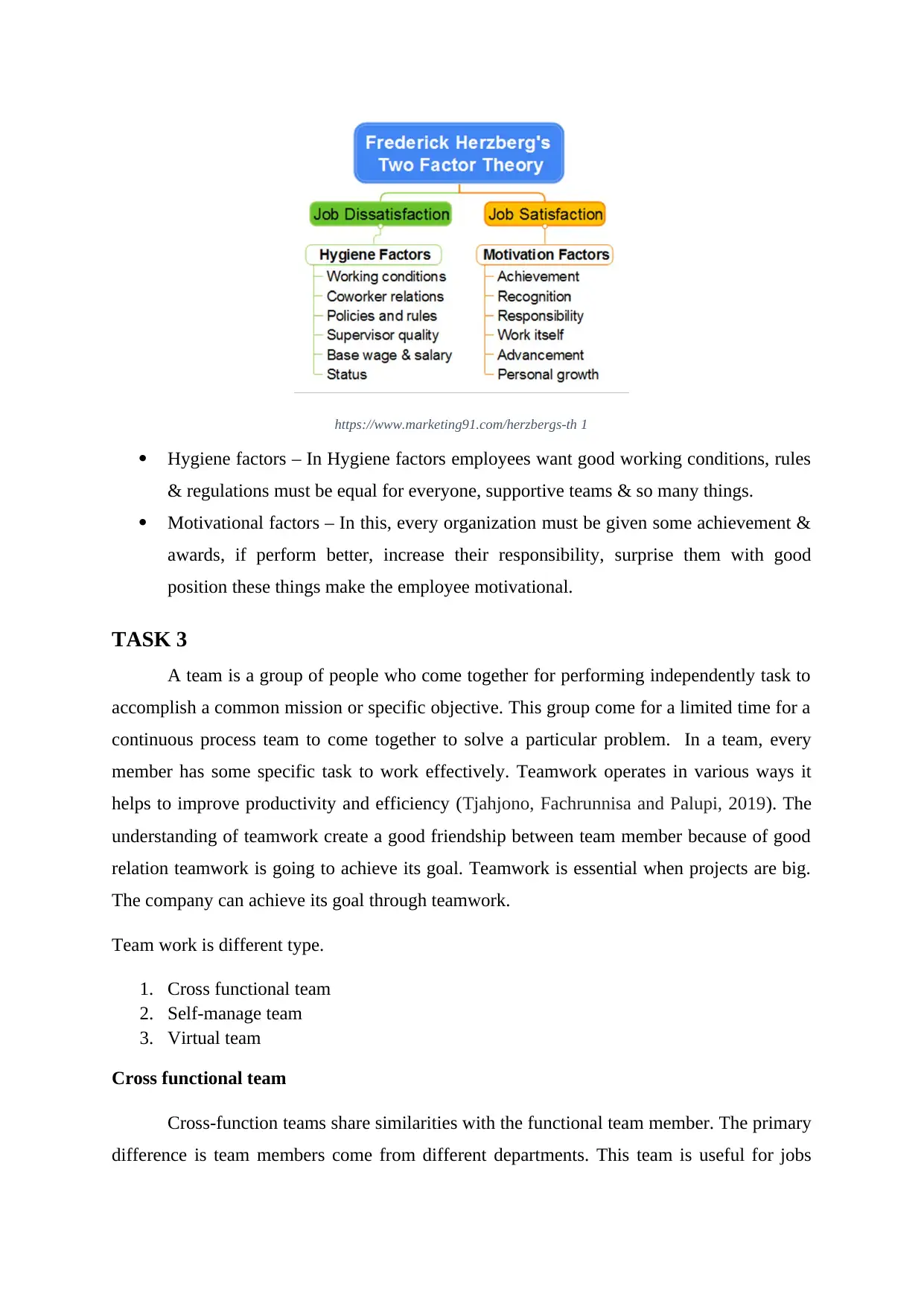
https://www.marketing91.com/herzbergs-th 1
Hygiene factors – In Hygiene factors employees want good working conditions, rules
& regulations must be equal for everyone, supportive teams & so many things.
Motivational factors – In this, every organization must be given some achievement &
awards, if perform better, increase their responsibility, surprise them with good
position these things make the employee motivational.
TASK 3
A team is a group of people who come together for performing independently task to
accomplish a common mission or specific objective. This group come for a limited time for a
continuous process team to come together to solve a particular problem. In a team, every
member has some specific task to work effectively. Teamwork operates in various ways it
helps to improve productivity and efficiency (Tjahjono, Fachrunnisa and Palupi, 2019). The
understanding of teamwork create a good friendship between team member because of good
relation teamwork is going to achieve its goal. Teamwork is essential when projects are big.
The company can achieve its goal through teamwork.
Team work is different type.
1. Cross functional team
2. Self-manage team
3. Virtual team
Cross functional team
Cross-function teams share similarities with the functional team member. The primary
difference is team members come from different departments. This team is useful for jobs
Hygiene factors – In Hygiene factors employees want good working conditions, rules
& regulations must be equal for everyone, supportive teams & so many things.
Motivational factors – In this, every organization must be given some achievement &
awards, if perform better, increase their responsibility, surprise them with good
position these things make the employee motivational.
TASK 3
A team is a group of people who come together for performing independently task to
accomplish a common mission or specific objective. This group come for a limited time for a
continuous process team to come together to solve a particular problem. In a team, every
member has some specific task to work effectively. Teamwork operates in various ways it
helps to improve productivity and efficiency (Tjahjono, Fachrunnisa and Palupi, 2019). The
understanding of teamwork create a good friendship between team member because of good
relation teamwork is going to achieve its goal. Teamwork is essential when projects are big.
The company can achieve its goal through teamwork.
Team work is different type.
1. Cross functional team
2. Self-manage team
3. Virtual team
Cross functional team
Cross-function teams share similarities with the functional team member. The primary
difference is team members come from different departments. This team is useful for jobs
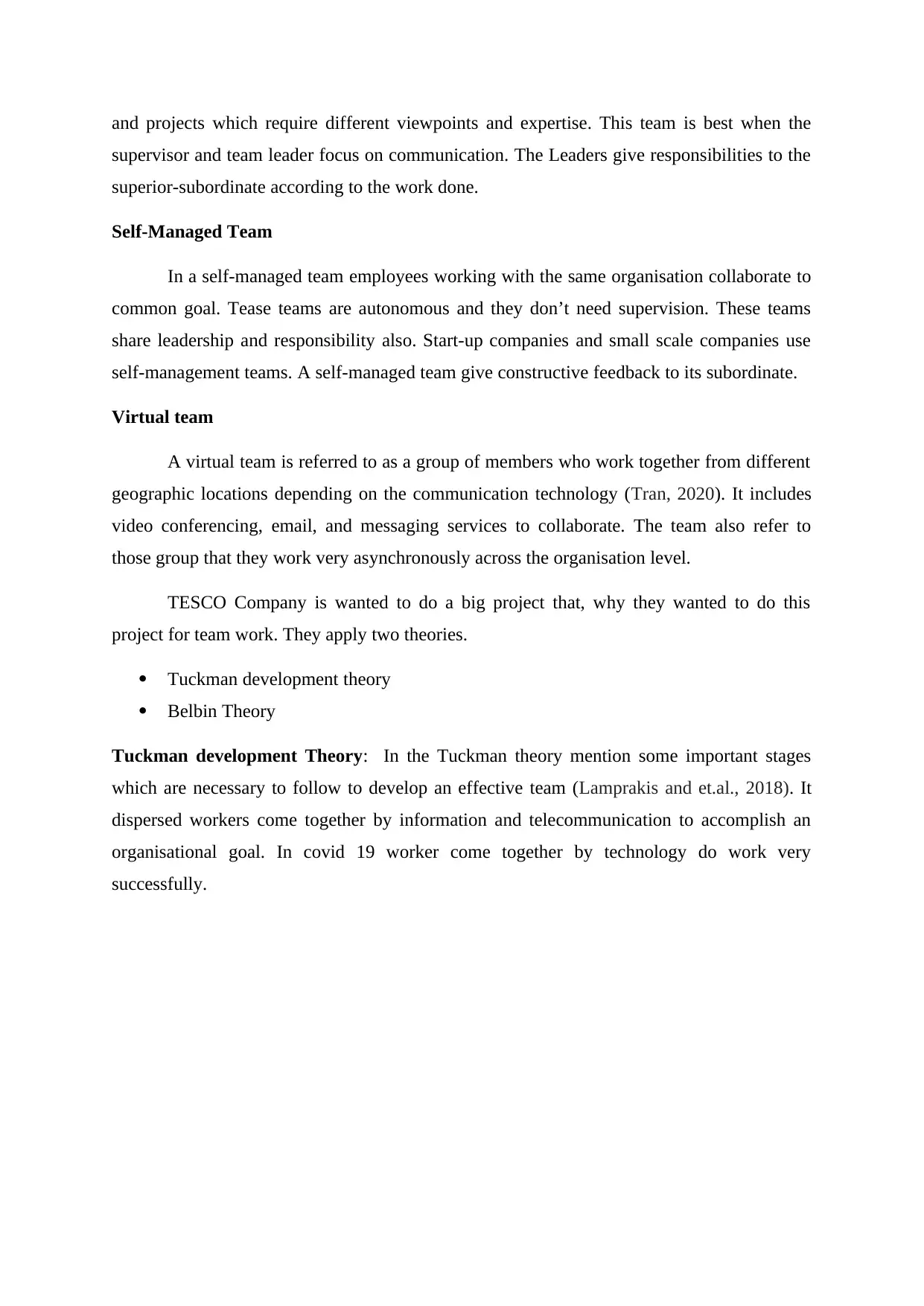
and projects which require different viewpoints and expertise. This team is best when the
supervisor and team leader focus on communication. The Leaders give responsibilities to the
superior-subordinate according to the work done.
Self-Managed Team
In a self-managed team employees working with the same organisation collaborate to
common goal. Tease teams are autonomous and they don’t need supervision. These teams
share leadership and responsibility also. Start-up companies and small scale companies use
self-management teams. A self-managed team give constructive feedback to its subordinate.
Virtual team
A virtual team is referred to as a group of members who work together from different
geographic locations depending on the communication technology (Tran, 2020). It includes
video conferencing, email, and messaging services to collaborate. The team also refer to
those group that they work very asynchronously across the organisation level.
TESCO Company is wanted to do a big project that, why they wanted to do this
project for team work. They apply two theories.
Tuckman development theory
Belbin Theory
Tuckman development Theory: In the Tuckman theory mention some important stages
which are necessary to follow to develop an effective team (Lamprakis and et.al., 2018). It
dispersed workers come together by information and telecommunication to accomplish an
organisational goal. In covid 19 worker come together by technology do work very
successfully.
supervisor and team leader focus on communication. The Leaders give responsibilities to the
superior-subordinate according to the work done.
Self-Managed Team
In a self-managed team employees working with the same organisation collaborate to
common goal. Tease teams are autonomous and they don’t need supervision. These teams
share leadership and responsibility also. Start-up companies and small scale companies use
self-management teams. A self-managed team give constructive feedback to its subordinate.
Virtual team
A virtual team is referred to as a group of members who work together from different
geographic locations depending on the communication technology (Tran, 2020). It includes
video conferencing, email, and messaging services to collaborate. The team also refer to
those group that they work very asynchronously across the organisation level.
TESCO Company is wanted to do a big project that, why they wanted to do this
project for team work. They apply two theories.
Tuckman development theory
Belbin Theory
Tuckman development Theory: In the Tuckman theory mention some important stages
which are necessary to follow to develop an effective team (Lamprakis and et.al., 2018). It
dispersed workers come together by information and telecommunication to accomplish an
organisational goal. In covid 19 worker come together by technology do work very
successfully.
⊘ This is a preview!⊘
Do you want full access?
Subscribe today to unlock all pages.

Trusted by 1+ million students worldwide
1 out of 21
Related Documents
Your All-in-One AI-Powered Toolkit for Academic Success.
+13062052269
info@desklib.com
Available 24*7 on WhatsApp / Email
![[object Object]](/_next/static/media/star-bottom.7253800d.svg)
Unlock your academic potential
Copyright © 2020–2025 A2Z Services. All Rights Reserved. Developed and managed by ZUCOL.





